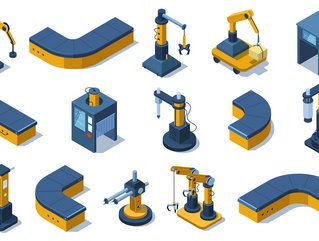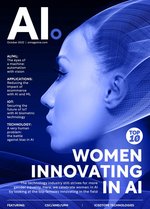The eyes of a machine: automation with vision

Opening the door to automation, the use of artificial intelligence (AI) has enabled industrial robotic applications to process large amounts of images and data in volumes that were previously not possible.
Now, with the introduction of machine vision, robotics and automation within manufacturing are set to transform the industry yet again and its increasing affordability means it will be making a huge impact on a number of companies, regardless of size.
Historically, data acquisition within computer vision has been limited by the manual interpretation of captured image data. However, the introduction of deep learning – a type of machine learning based on artificial neural networks – has generated data-driven models that could replace handcrafted preprocessing and feature extraction.
The evolution of computer vision started with basic neural networks being able to recognise handwritten numbers from zero to nine. Today, with the advancement of GPUs and large datasets, we can accurately identify just about anything from people to dogs to household objects in video.
“Vision is essential for an organism to understand the world around it beyond touch. However, it's not a simple process. More than 50% of the cortex – the surface of the human brain – is devoted to processing visual information. This demonstrates the volume of processing resources that need to be devoted to it, and it’s the same in robots and other artificial intelligence. Vision is very challenging but adds enormous capability,” notes Eleanor Watson, IEEE AI Ethics engineer and AI Faculty at Singularity University.
The technology, when applied to robotics, enables machines to perceive their surroundings, recognise individuals and objects, understand context, discern the attributes of things, and freely navigate environments.
With these abilities, machine vision can enable the contextual awareness required for robots to work closely alongside humans and adapt to changes in the environment by applying AI to learning new work patterns.
“Apart from the most common use cases – using visual information to check on the status of quality, position or inspection of tasks – machine vision’s value is flexibility and contextual awareness. Today’s industrial robotics are required to intelligently react and adjust to changes in the immediate surroundings, including safety functions when you have encroachment of the physical workspace,” explains Bjorn Andersson, Senior Director, Global IoT at Hitachi Vantara.
Without machine vision technology, machines could not know where to find objects to pick them off a conveyor or out of a box, could not perform quality control on stock to check for damage or missing pieces, and couldn’t recognise a catastrophic error to notify a human colleague.
“Advanced machine vision allows for greatly improved mobility and independence. Traditional industrial robots live in a literal cage and cannot easily be repositioned, let alone reposition themselves. Modern robots take themselves wherever they anticipate the greatest need, with minimal oversight or correction necessary from a human guide,” comments Watson.
Increasing robotic applications with affordable machine vision
Affordability has always been a problem within the robotics industry. Those who have historically been able to afford the technology have been leaps and bounds ahead of their competitors, whereas those who haven’t been able to afford it lag significantly behind.
“We’ve passed an inflexion point where machine vision is now available, affordable and fast enough to be used in practice. Data, computing power and affordability are the three main ingredients for a step function improvement,” explains Andersson.
“IoT brought us the data and the continuous improvement of computing hardware, while algorithms gave us computing power. Add to that the affordability to deploy it essentially everywhere, then it’s enabling fundamental changes in how we work,” he adds.
On top of this improved affordability, machine vision often utilises deep learning technology to elevate it further. The pair go hand in hand: when you add deep learning algorithms, it gives robotics intelligent vision, bestowing them with the ability to recognise objects, thus taking robotics to a new level of efficiency.
“Machine vision is one of several areas where deep learning models not only outperform other machine learning approaches, but are able to achieve accuracy comparable to humans,” notes Prashant Natarajan, Vice President of Strategy and Products at H2O.ai.
“Moreover, using modern hardware, deep learning models can produce the predictions within milliseconds, allowing real-time applications for machine visions. Such applications include recognising the surrounding environment and making decisions accordingly. That enables a wide range of tasks to be automated in industrial robotics,” he continues.
Machine vision, robotics and its future in a private cloud
Looking to the future, the opportunities for machine vision within robotics are closely linked with the private cloud, which, according to TCS, is expected to continue maturing.
“Computer vision’s preference for the private cloud is all about latency and physics. In most applications that interact with humans, latency is noticeable when you go beyond a few milliseconds. You will start to notice if the time to gather the image data, send it somewhere to do the processing and then deliver the result back takes longer than that,” comments Andersson.
However, Natarajan outlines the importance of a private cloud as it enables all the benefits of cloud technologies without privacy and security concerns: “It is crucial for computational-heavy tasks like computer vision, where availability of the appropriate hardware to train and execute the models fast is crucial. Together with resource scalability, private clouds enable the fast adoption of cloud-based AI technologies that are already tailored for computer vision applications.”
He concludes: “AI cloud solutions can bring state-of-the-art deep learning to solve industrial computer vision problems, utilising the innovative AI methods built on top of the modern cloud technology stack.”







